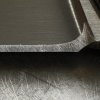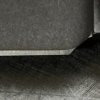-
The BladeForums.com 2024 Traditional Knife is ready to order! See this thread for details: https://www.bladeforums.com/threads/bladeforums-2024-traditional-knife.2003187/
Price is $300 ea (shipped within CONUS). If you live outside the US, I will contact you after your order for extra shipping charges.
Order here: https://www.bladeforums.com/help/2024-traditional/ - Order as many as you like, we have plenty.
You are using an out of date browser. It may not display this or other websites correctly.
You should upgrade or use an alternative browser.
You should upgrade or use an alternative browser.
What's the purpose of a sharpening choil ?
- Thread starter Chapp
- Start date
- Status
- Not open for further replies.
- Joined
- Oct 31, 2009
- Messages
- 11,796
It's so that you can sharpen the entire cutting edge without cutting into the ricasso, or leaving a dull portion ahead of the ricasso.Is there any real practical reason behind it ? I'm curious.
- Joined
- May 9, 2002
- Messages
- 12,606
It's so that you can sharpen the entire cutting edge without cutting into the ricasso, or leaving a dull portion ahead of the ricasso.
Daggone, now it makes sense. I've been dragging my secondary knife blade through it like a carbide sharpener. No wonder it didn't work worth a hoot.
- Joined
- Nov 20, 2005
- Messages
- 19,385
Some people like a choil and some don't. I generally do on my fixed blades.
- Joined
- Apr 6, 2017
- Messages
- 1,743
As noted by Danbot, it's intended to aid in sharpening by keeping your stone only on the edge, and not allowing it to ride up on the ricasso due to a poorly implemented plunge grind, which can cause other issues like a recurve later on in a knife's life. Depending on the tools you use and the design of a knife, a sharpening choil may or may not be required. For example, very few spyderco knives have sharpening choils, but due to their properly done plunge grinds, they're still pretty easy to sharpen all the way to the heel.
Last edited:
- Joined
- Jun 30, 2016
- Messages
- 4,689
Daggone, now it makes sense. I've been dragging my secondary knife blade through it like a carbide sharpener. No wonder it didn't work worth a hoot.
This made me genuinely laugh out loud. Thanks.
- Joined
- Oct 31, 2009
- Messages
- 11,796
Ah, common mistake! Although it can double as a wire stripper!Daggone, now it makes sense. I've been dragging my secondary knife blade through it like a carbide sharpener. No wonder it didn't work worth a hoot.

Currawong
Gold Member
- Joined
- May 19, 2012
- Messages
- 2,254
It’s there to catch on things and make your job harder.
Exactly. That's my main experience of them.
- Joined
- May 9, 2002
- Messages
- 12,606
I don't see how people get by using only 99.98% of the blade...savages.
NapalmCheese
Basic Member
- Joined
- Aug 24, 2006
- Messages
- 855
Well I mean if you really look at it, the amount of blade that can't be sharpened because of the lack of a sharpening choil is probably about the same as the amount of the blade that gets ground off to make a sharpening choil...I don't see how people get by using only 99.98% of the blade...savages.
SALTY
Gold Member
- Joined
- Mar 19, 2000
- Messages
- 5,790
I'd rather endure 1% or 2% of the blade being unsharpened or poorly sharpened rather than have the sharpening choil catch on everything - as they do. They may only be 2% +/- of the blade's length but seem to be in the way snagging on things a highly disproportionate amount of time.
- Joined
- Jan 11, 2019
- Messages
- 134
I've always wondered if there was any functional benefit to them.
They look cool, is about all I can figure.
Other than that, it always seemed to me to be a built in snag.
They look cool, is about all I can figure.
Other than that, it always seemed to me to be a built in snag.
- Joined
- Mar 8, 2008
- Messages
- 25,891
It's mostly there for cosmetic reasons, and could be eliminated from most designs with a little tweaking in the design phase. It helps eliminate a cosmetic recurve much much later on in the knife's life from improper sharpening...or earlier on, during production, where it's not uncommon for the base of the blade to get unevenly ground. 
I don't see how people get by using only 99.98% of the blade...savages.
- Joined
- Apr 8, 2016
- Messages
- 6,630
It can cause a recurve or a smile for some when sharpening if there is no choil. The fact is not everyone has a belt grinder to sharpen the knives the maker used to sharpen without a choil. They can absolutely catch on some things. If you make a proper choil it doesn't have to do that.
Either way a choil is necessary when sharpening to the base of the knife. Else you have to stop short or make a so called smile at the plunge or a recurve near the plunge depending on the geometry of that specific knife.
Same topic on this link via @DeadboxHero
https://www.instagram.com/p/BtkNo_8BZkT/?utm_source=ig_share_sheet&igshid=wg3f6sdo10e8
Here's one example The bottom knife stops short due to the plunge.

This one's a nice choil, but it may catch on things. However using a cone shape sharpening rod one can make it a serration to make it less of an issue...

The base of the pm2 is really time consuming to do this...

So most will do this

Either way a choil is necessary when sharpening to the base of the knife. Else you have to stop short or make a so called smile at the plunge or a recurve near the plunge depending on the geometry of that specific knife.
Same topic on this link via @DeadboxHero
https://www.instagram.com/p/BtkNo_8BZkT/?utm_source=ig_share_sheet&igshid=wg3f6sdo10e8
Here's one example The bottom knife stops short due to the plunge.

This one's a nice choil, but it may catch on things. However using a cone shape sharpening rod one can make it a serration to make it less of an issue...

The base of the pm2 is really time consuming to do this...

So most will do this

this is not idea for sharpening. Almost always looks bad and not the right way to sharpen.
Last edited:
- Joined
- Jul 24, 2007
- Messages
- 3,285
That's not the point. It's not about not sharpening the whole edge, it's that the sharpening stone rides up on the unsharpened part by the ricasso, which in the long run will lead to an unevenly sharpened or slightly deformed edge, because some parts of the edge will receive different amounts of pressure from the stone.I'd rather endure 1% or 2% of the blade being unsharpened or poorly sharpened rather than have the sharpening choil catch on everything - as they do. They may only be 2% +/- of the blade's length but seem to be in the way snagging on things a highly disproportionate amount of time.
If you have clearance behind the edge by the ricasso, it gets easier to sharpen evenly without deforming the edge, since you don't have to even get close to the corner of the stone with your edge.
This is extra useful on Chef's knives, since they have thin edges and one of the reasons why they usually have a lot of clearance behind the edge:

On a knife like this, there is nothing that can ever get in the way of the sharpening stone while sharpening. You could basically sharpen it on a stone floor.
- Status
- Not open for further replies.


